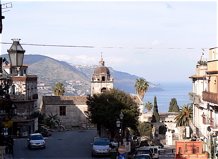Little Sicily off the southern foot of Italy is an ancient land of history and civilization. From the early Greeks to modern hip, the island has received conquerors and travelers. Today it is a quiet corner of Italy with memories of gay artists, artisans and romance seekers in the hillside town of Taormina and with a modest active scene in the bigger cities.
Also see:
Gay Italy Stories
Gay Italy News & Reports 2000 to present
Gay Italy Photo Galleries
By Richard Ammon
GlobalGayz.com
March 2007
The history of gay Sicily is centered on the little east coast town of Taormina built high on a rocky outcropping with spectacular views of the deep blue Mediterranean and (in winter) the stunning snow capped volcano Mt Etna.
The high-perch views can hardly be matched anywhere in Europe. It is an artist’s dream, an adventurer’s wonder, a trekker’s heaven, a romantic’s rainbow end.
And so it was in ancient Greece then followed by Roman soldiers and settlers—who built a huge amphitheatre–through numerous conquering civilizations into the 19th century. Here artist’s came to find inspiration, to soothe anguished souls, cavort with the sea, socialize with the elite or engage in aesthetic or carnal endeavors.
The man most responsible for the blossoming of gay life in this village was the 19c Baron Wilhelm von Gloeden, an aristocratic German painter and photographer whose eye for beauty ranged from scenic landscapes to wrinkled farmers to innocent-looking pubescent boys (mostly) and girls (some). Von Gloeden’s photos, starting in the 1880’s, of tawny smooth youths tapped into the sensual fantasies of closeted or socially frustrated denizens from northern Europe longing for relief from the dreary winter months and an outlet for artistic or sexual energies.
an aristocratic German painter and photographer whose eye for beauty ranged from scenic landscapes to wrinkled farmers to innocent-looking pubescent boys (mostly) and girls (some). Von Gloeden’s photos, starting in the 1880’s, of tawny smooth youths tapped into the sensual fantasies of closeted or socially frustrated denizens from northern Europe longing for relief from the dreary winter months and an outlet for artistic or sexual energies.
One of the earliest aesthetes to respond to von Gloeden’s inspiration was Oscar Wilde who became friends with the photographer and spent more than a few months in Taormina as he worked on his plays, essays, poetry and considerable correspondence with the glitterati of Europe. This was before his disastrous relationship with Lord Alfred Douglas in England. It is said that Wilde even helped von Gloeden stage some of his photos with props and settings from antiquity, garbing some youths with head garlands or draping togas.
Whatever the exact details of their association, a community of like-minded souls made their way to Toarmina at one time or another over the course of the next fifty years, until the rise of fascism in the thirties and into WW II when homophobia (a cornerstone of fascist policy) increased and travel to Sicily became difficult or undesirable.
In his voluminous book ‘Mussolini’s Italy-Life under the Dictatorship 1915-1945’ author R.J.B. Bosworth briefly mentions von Gloeden’s arrival in Taormina in 1876 and the subsequent minor ‘wave’ of tourism that followed his photographic exhibition in Berlin in the 1880s of a romanticized Sicily: peasants, farmers, landscapes, old folks and young nude men.
Bosworth goes on to describe the fascist purges against gays in Catania (the large city twenty miles south of Taormina) in the 1930s driven in part by pope Pius XI’s 1931 encyclical decree Casti Connubi that “anathematized any sex not directed at procreation.” Other fascist officials in the thirties in Catania railed against the ‘homosexual plague’ threat to a purified Italy.
After the second World War Taormina continued its appeal to adventurous and aesthetic temperaments. Legend has it that Truman Capote, Tennessee Williams, Somerset Maugham, Jean Cocteau and their coteries of friends and devotees set foot on the ancient stone streets and winding ‘wanderwegs’ of Taormina desirous of seeing the ‘boys with the almond eyes’.
 Of course little Taormina was no match for the sophisticated salons and studios of Paris or Berlin or New York but it continued its quiet reputation as an enviable place of great beauty between dramatic Etna and the endless azure sea. In Wilde’s day it took more almost a week to get from London to Sicily and stays lasted for a season, accompanied by steamer trunks, hat boxes, formal wear, polished boots and outfits that would make today’s wardrobes wilt: ‘home away from home’ had real meaning then.
Of course little Taormina was no match for the sophisticated salons and studios of Paris or Berlin or New York but it continued its quiet reputation as an enviable place of great beauty between dramatic Etna and the endless azure sea. In Wilde’s day it took more almost a week to get from London to Sicily and stays lasted for a season, accompanied by steamer trunks, hat boxes, formal wear, polished boots and outfits that would make today’s wardrobes wilt: ‘home away from home’ had real meaning then.
Fast forward to the late 20th century when gay lib began to expand across western Europe and America. Gay organizations demanded public attention with legislation, parades and venues, although Italy lagged behind the more vocal gay epicenters abroad.
However, the country was not content to be left behind. The national Italian LGBT organization Arcigay was born in 1985 by Franco Grillini (now an MP in Rome) to break the silence around homosexuality. It went on to become a primary host for WorldPride in Rome in 2000 despite much protest and anguish from the Vatican (2000 was also a ‘jubilee year’ for the Church with millions of pilgrims arriving) but supported by a huge influx of LGBT folks from around the world.
It was a jolt to the conservative Italian mind but brought new energy and demands for respect and gay equality in numerous cities from north to south.
 Meanwhile in Sicily, Taormina had reached another heyday in the ‘70s to the mid ‘90s–although with lesser celebrities–when there were as many as half a dozen gay venues. It constituted a ‘hotspot’ since conservative southern Italy was virtually devoid of such notable attractions and personalities.
Meanwhile in Sicily, Taormina had reached another heyday in the ‘70s to the mid ‘90s–although with lesser celebrities–when there were as many as half a dozen gay venues. It constituted a ‘hotspot’ since conservative southern Italy was virtually devoid of such notable attractions and personalities.
However, everything changes. Taormina began to fade from its niche as various gay and gay-friendly venues opened and closed (mostly) subject to the whim of travelers and the increasing ease of travel to other places.
The lack of LGBT venues in Taormina has corresponded with the drop in gay visitors to Taormina as new and trendy places opened in other Sicilian cities such as Palermo, Catania and Messina.
 Catania, twenty kilometers south of Taormina, has a population of over 300,000 while Taormina’s is about 11,000. Catania is reported to have two saunas, three discos and two bars while Palermo has two discos. Sicily’s other large city, Messina has had venues open and close frequently. “People are more open (read: indifferent) in those big cities,” one person noted.
Catania, twenty kilometers south of Taormina, has a population of over 300,000 while Taormina’s is about 11,000. Catania is reported to have two saunas, three discos and two bars while Palermo has two discos. Sicily’s other large city, Messina has had venues open and close frequently. “People are more open (read: indifferent) in those big cities,” one person noted.
Not surprisingly, there is Arcigay (national LGBT organization) political activity in Catania as well as a modest level of Pride visibility. In addition to Arcigay, Catania has it’s own activist group called ‘Open Mind’.
In Palermo 2006 a branch of Arcilesbica reopened after a hiatus of several years. Given the well-known influence of the mafia in these major Sicilian cities and their strong family loyalties (read, homophobia) any public LGBT presence is considered a success.
Today in Taormina there is just one year-round gay establishment, a small five-room hotel that is able to survive because it owns the building it inhabits and is free from exorbitant rent. Isocos Hotel (Via Salita Branco, 2; www.isoco.it) is owned and operated by Michele Scimone whose family has lived in Taormina for four generations.
 Friendly, polite and informative, Michele has decorated the hotel in appropriate ‘attire’ and each room is named for a famous gay icon. We stayed in the von Gloedon room, next to the Herb Ritts room. The others are the Pierre & Giles, Botticelli and Keith Haring rooms.
Friendly, polite and informative, Michele has decorated the hotel in appropriate ‘attire’ and each room is named for a famous gay icon. We stayed in the von Gloedon room, next to the Herb Ritts room. The others are the Pierre & Giles, Botticelli and Keith Haring rooms.
In the summer, there is the once-gay now-mixed Q Loungebar. A recently renovated Saint Honore café drips with a ‘gay look’ but is not according to Michele, despite several photos of von Gloedon’s hung on the walls and a recent book of his works on a shelf.
In addition to Isocos there are two other gay-friendly hotels: the 4-star Hotel Schuller and the smaller Pensione Adele.
Even though Taormina is not the happening place it once was many gay folks still come especially in August for the beautiful beaches and town ambience. For some, it’s only after they arrive that they discover the faded gay truth of Taormina; it’s historic aura still holds for some. But high-gay or no-gay the town’s setting and charm clearly weave their spell on those who come. No one goes home disappointed.
So ‘gay Sicily’ is an intriguing historical story of romance and aesthetics focused on tiny Taormina as well as a modern tale of urban action now focused in the big cities.


















